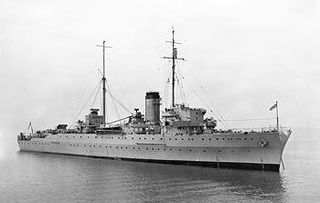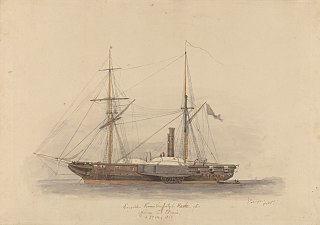
HMS Amazon was the first Type 21 frigate of the Royal Navy. Her keel was laid down at the Vosper Thornycroft shipyard in Southampton, England. The ship suffered a fire in the Far East in 1977, drawing attention to the risk of building warships with aluminium superstructure.

RFA Fort Rosalie was the lead ship of her class of Royal Fleet Auxiliary fleet replenishment ships. Fort Rosalie was originally named RFA Fort Grange, but was renamed in May 2000 to avoid confusion with the now-decommissioned RFA Fort George. On 31 March 2021, the ship was withdrawn from service.

HMS Glamorgan was a County-class destroyer of the Royal Navy with a displacement of 5,440 tonnes. The ship was built by Vickers-Armstrongs in Newcastle Upon Tyne and named after the Welsh county of Glamorgan.

HMS Plymouth was a Royal Navy Rothesay-class frigate. In 1982, Plymouth was one of the first Royal Navy ships to arrive in the South Atlantic during the Falklands War.

HMS Danae was a Leander-class frigate of the Royal Navy. She was, like the rest of the class, named after a figure of mythology. Danae was built by Devonport Dockyard. She was launched on 31 October 1965 and commissioned on 10 October 1967.

The Hecla class formed the backbone of the Royal Navy's ocean survey fleet from the mid-1960s.

HMS Hecla was the lead ship of the Hecla class, an oceangoing survey ship type in the Royal Navy. She was ordered in the mid-1960s, along with her sister ships HMS Hecate and HMS Hydra. A fourth ship, HMS Herald, was completed in the early 1970s. The ship served for thirty years in this role, and various others, before finally being replaced by HMS Scott in 1997. Hecla was sold to private interests, being renamed "Bligh" after Vice-Admiral William Bligh. After this, the vessel was used in a hydrographic survey of Irish waters, and was based in Waterford, Ireland.

HMS Dumbarton Castle (P265) was an offshore patrol vessel of the British Royal Navy. Her main role was the protection of the offshore assets of the United Kingdom, including oil and gas installations and fisheries out to the 200-nautical-mile limit.

HMS Herald was a Hecla-class ocean survey ship that served with the Royal Navy during both the Falklands War and Gulf War.

HMS Hydra was a Royal Navy deep ocean hydrographic survey vessel, the third of the original three of the Hecla class. The ship was laid down as yard number 2258 on 14 May 1964 at Yarrow Shipbuilders, at Scotstoun on the River Clyde and launched on 14 July 1965 by Mary Lythall, wife of the then Chief Scientist, Basil W Lythall CB (1919–2001). She was completed and first commissioned on 4 May 1966 and, as the replacement for the survey ship HMS Owen, her commanding officer and many of her ship's company formed the first commission of HMS Hydra. She was decommissioned and sold to the Indonesian Navy in 1986 and renamed KRI Dewa Kembar ; she was still in service in 2019.

HMS Olympus was an Oberon-class submarine that served in the Royal Navy, and later in the Canadian Forces as a submarine trainer.

HMS Protector was an Antarctic patrol vessel of the Royal Navy between 1955 and 1968. She was built in 1935 as a net laying ship.
HMS Iveston was a Ton-class minesweeper of the Royal Navy launched on 1 June 1954 by Philip and Son in Dartmouth. After her decommissioning in 1992, HMS Iveston became the Sea Cadet training ship T.S. Iveston. She was sold and scrapped in March 2015.

BNS Gomati is an Island-class offshore patrol vessel of the Bangladesh Navy. She was originally built as a Fishery Protection Vessel for the British Royal Navy, entering service as HMS Anglesey in 1979. She was sold to Bangladesh in 2002, entering service in 2003.
Five ships of the Royal Navy have borne the name HMS Hecate, after Hecate, a goddess in early Greek mythology:
HMS Hodgeston was a Ton-class minesweeper which saw service with the Royal Navy during the Cold War. Built by Fleetlands Shipyard, she was launched on 6 April 1954 and broken up in 1988.
HMS Brereton (M1113) was a Ton-class minesweeper of the Royal Navy. Brereton was built by the Lowestoft shipbuilder Richard Ironworks, and was launched in 1953 and entered service in 1954.

The Hydra class were a class of three paddlewheel steam sloops of the British Royal Navy. They saw active service variously in the Baltic during the Crimean War, against Ottoman forces in Syria and against slavers in West Africa. Latterly Hydra and Hecate were used for survey in the Mediterranean, the Pacific, Australia and the Atlantic, and thus their names were re-used for the Hecla-class survey vessels in the late 20th century. Two of the class were broken up after more than twenty-five years of service, and Hecla was sold for commercial use in 1863.

HNLMS Van Kinsbergen (F809) was a frigate of the Kortenaer class. The ship was in service with the Royal Netherlands Navy from 1980 to 1995. The frigate was named after Dutch naval hero Jan Hendrik van Kinsbergen.














